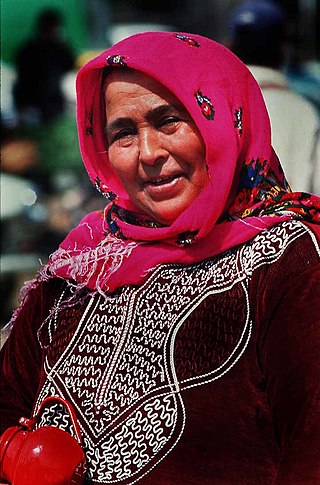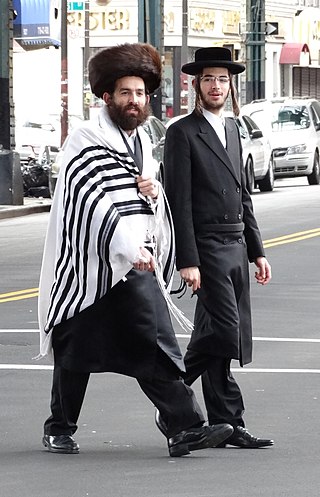Related Research Articles

In modern usage, hijab generally refers to various head coverings conventionally worn by many Muslim women. It is similar to the tichel or snood worn by Orthodox Jewish women, certain headcoverings worn by some Christian women, such as the mantilla, apostolnik and wimple, and the dupatta worn by many Hindu and Sikh women. Whilst a hijab can come in many forms, it often specifically refers to a scarf wrapped around the head, covering the hair, neck and ears but leaving the face visible. The use of the hijab has been on the rise worldwide since the 1970s and is viewed by many Muslims as expressing modesty and faith; it has also been worn for purposes of adornment. When it comes to the obligation for a Muslim woman to cover her hair and body, many have expressed confusion about the origin of this commandment. However, there has never been any debate within Sunni Islamic scholarship at any point in history regarding the obligation of hijab for all Muslim women who have reached the age of puberty.

Modesty, sometimes known as demureness, is a mode of dress and deportment which intends to avoid the encouraging of sexual attraction in others. The word modesty comes from the Latin word modestus which means 'keeping within measure'.

A swimsuit is an item of clothing designed to be worn by people engaging in a water-based activity or water sports, such as swimming, diving and surfing, or sun-orientated activities, such as sun bathing. Different types may be worn by men, women, and children. A swimsuit can be described by various names, some of which are used only in particular locations or for particular types of suit, including swimwear, bathing suit, bathing attire, swimming costume, bathing costume, swimming suit, swimmers, swimming togs, bathers, cossie, or swimming trunks, besides others.
Tzniut describes the character trait of modesty and discretion, as well as a group of Jewish laws pertaining to conduct. The concept is most important within Orthodox Judaism.

Islamic clothing is clothing that is interpreted as being in accordance with the teachings of Islam. Muslims wear a wide variety of clothing, which is influenced not only by religious considerations, but also by practical, cultural, social, and political factors. In modern times, some Muslims have adopted clothing based on Western traditions, while others wear modern forms of traditional Muslim dress, which over the centuries has typically included long, flowing garments. Besides its practical advantages in the climate of the Middle East, loose-fitting clothing is also generally regarded as conforming to Islamic teachings, which stipulate that body areas which are sexual in nature must be hidden from public view. Traditional dress for Muslim men has typically covered at least the head and the area between the waist and the knees, while women's islamic dress is to conceal the hair and the body from the ankles to the neck. Some Muslim women also cover their face. However, other Muslims believe that the Quran strictly mandate that women need to wear a hijab or a burqa.

A headscarf is a scarf covering most or all of the top of a person's, usually women's, hair and head, leaving the face uncovered. A headscarf is formed of a triangular cloth or a square cloth folded into a triangle, with which the head is covered.

A prairie dress or prairie skirt is a modest American style of skirt, an article of women's and girls' clothing.
Outward holiness, or external holiness, is a Wesleyan–Arminian doctrine emphasizing modest dress and sober speech. It is a testimony of a Christian believer's regeneration, done in obedience to God. The doctrine is prevalent among denominations emerging during the revival movements, including the Methodists, as well as Pentecostals. It is taken from 1 Peter 1:15: "He which hath called you is Holy, so be ye holy in all manner of conversation."

According to halacha, married Jewish women are expected to cover their hair when in the presence of men other than their husband or close family members. Such covering is common practice nowadays among Orthodox Jewish women.
Many Christians have followed certain dress codes during attendance at church. Customs have varied over time and among different Christian denominations. As with the Bible, the Church Fathers of Christianity taught modesty as a core principle guiding the clothing that Christians are to manufacture and wear.

A burkini is a style of swimsuit for women. The suit covers the whole body except the face, the hands, and the feet, while being light enough for swimming. This type of swimwear was designed with the intention of creating swimwear for Muslims who observe hijab in this way. The amount of skin covered is about the same as the person wearing a wetsuit and a swimming cap.

Trousers are a staple of historical and modern fashion. Throughout history, the role of trousers is a constant change for women. The first appearance of trousers in recorded history is among nomadic steppe-people in Western Europe. Steppe people were a group of nomads of various different ethnic groups that lived in the Eurasian grasslands. Archaeological evidence suggests that men and women alike wore trousers in that cultural context. However, for much of modern history, the use of trousers has been restricted to men. This norm was enforced in many regions due to social customs and laws. There are, however, many historical cases of women wearing trousers in defiance of these norms such as the 1850s women rights movement, comfort, freedom of movement, fashion, disguise, attempts to evade the gender pay gap, and attempts to establish an empowered public identity for women. Especially in the 20th and 21st centuries, the customs and laws restricting this manner of dress have relaxed dramatically, reflecting a growing acceptance and normalisation of the practice.

Plain dress is a practice among some religious groups, primarily some Christian churches in which people dress in clothes of traditional modest design, sturdy fabric, and conservative cut. It is intended to show acceptance of traditional gender roles, modesty, and readiness to work and serve, and to preserve communal identity and separation from the ever-changing fashions of the world. For men, this often takes the form of trousers secured by suspenders, while for women, plain dress usually takes the form of a cape dress along with a headcovering.
Religious clothing is clothing which is worn in accordance with religious practice, tradition or significance to a faith group. It includes clerical clothing such as cassocks, and religious habit, robes, and other vestments. Accessories include hats, wedding rings, crucifixes, etc.

Jewish religious clothing is apparel worn by Jews in connection with the practice of the Jewish religion. Jewish religious clothing has changed over time while maintaining the influences of biblical commandments and Jewish religious law regarding clothing and modesty (tzniut). Contemporary styles in the wider culture also have a bearing on Jewish religious clothing, although this extent is limited.

Shalwar kameez is a traditional combination dress worn by men and women in South Asia, and Central Asia.

The clothing style and fashion sense of the Philippines in the modern-day era have been influenced by the indigenous peoples, Chinese waves of immigration, the Spaniards, and the Americans, as evidenced by the chronology of events that occurred in Philippine history. At present, Filipinos conform their way of dressing based on classic fashion or prevailing fashion trends.

The term modest fashion or modest dressing refers to a fashion trend in women of wearing less skin-revealing clothes, especially in a way that satisfies their spiritual and stylistic requirements for reasons of faith, religion or personal preference. The exact interpretation of 'modest' varies across cultures and countries. There is no unambiguous interpretation as it is influenced by socio-cultural characteristics of each country. Beyond the various interpretations, all agree on the idea that modest fashion means loose clothing, comfortable dressing and covering of the body according to person's own comfort.

The skin gap is the difference in the amount of skin that men and women are expected to show in the same social setting. The term was coined in 2016 by Allison Josephs of Jew in the City. Josephs observed that in Western culture in 2016, women were generally expected to wear less clothing than men. An exception was made for women who did not meet the conventional standard of beauty, for example older or heavyset women; otherwise, there was a great deal of social pressure on women to display their bodies.

Most Sudanese wear either traditional or western attire. A traditional garb widely worn by Sudanese men is the jalabiya, which is a loose-fitting, long-sleeved, collarless ankle-length garment also common to Egypt. The jalabiya is often accompanied by a large turban and a scarf, and the garment may be white, coloured, striped, and made of fabric varying in thickness, depending on the season of the year and personal preferences.
References
- ↑ Melewar, T. C.; Alwi, S. F. Syed (2017). Islamic Marketing and Branding: Theory and Practice. Taylor & Francis. ISBN 978-1-317-11223-5.
- ↑ Eglash, Ruth (11 September 2016). "How the burkini debate boosted sales of modest swimwear in Israel". The Washington Post . Retrieved 6 November 2020.
- ↑ O'Brien, Glen (17 April 2018). Wesleyan-Holiness Churches in Australia: Hallelujah under the Southern Cross. Routledge. ISBN 978-1-351-18921-7.
- ↑ Marzel, Shoshana-Rose; Stiebel, Guy D. (18 December 2014). Dress and Ideology: Fashioning Identity from Antiquity to the Present. Bloomsbury Publishing. p. 98. ISBN 978-1-4725-5809-1.
A believing Muslim woman will not wear pants (bantalon) for two reasons. Firstly, pants might reflect the contours of limbs that are supposed to remain hidden. Secondly, items of clothing associated with men are off limits, just as men are forbidden to wear women's clothing. According to the Prophet, Allah curses the woman who dresses in clothing meant for men, and the man who wears clothing meant for women.
- ↑ Laneri, Raquel (5 June 2019). "Conservative women pushing back on skimpy bikini culture". New York Post . Retrieved 6 November 2020.
- ↑ Blatter, Lucy Cohen (1 June 2016). "Covered-up chic: Modest swimwear is having a moment". Jewish Telegraphic Agency . Retrieved 6 November 2020.
- ↑ "Jerusalem - Modest Swim Suits With 'Hechsher' Of Israeli Rabbis". Vos Iz Neias. 19 June 2009. Retrieved 6 November 2020.
- ↑ Mark, Jonathan (21 August 2018). "King Harvest Has Surely Come". The Times of Israel . Retrieved 6 November 2020.
- ↑ Dawn, Eden (20 March 2017). "One of Oregon's Most Successful Designers Makes Modesty Garb in La Grande". Portland Monthly . Retrieved 6 November 2020.
- ↑ Rosner, Batya Rosner (29 July 2015). "Modest Swimwear Makes a Splash". Orthodox Union . Retrieved 6 November 2020.